Introduction

South Sudan continues to face major barriers to building effective communication infrastructure due to decades of instability, vast rural areas, and limited development. Traditional telecom systems, such as mobile and fiber-optic networks, have not reached large portions of the country, especially in remote communities. Satellite communication, however, offers a new opportunity to provide nationwide connectivity. These networks could drastically improve access to digital services, support emergency operations, and aid in development across multiple sectors.
Widespread Connectivity Gaps
Access to reliable communication in South Sudan remains a major challenge. Outside the capital, Juba, many regions lack dependable mobile service or internet access. Fiber networks are scarce, and mobile towers are few and far between, leaving millions of people disconnected from digital platforms, markets, and public services.
This isolation hinders educational efforts, delays healthcare delivery, and restricts economic participation. In such an environment, satellite technology stands out as a practical solution. It can reach areas that are too remote or insecure for traditional infrastructure, offering a lifeline to underserved communities.
Satellite Systems as a Game-Changer
Modern satellite systems, including low Earth orbit (LEO) and geostationary satellites, are increasingly used to provide internet coverage across large, underdeveloped regions. These systems do not rely on ground-based infrastructure, making them ideal for South Sudan’s terrain and logistical challenges.
Some humanitarian organizations in the country already use satellite phones and VSATs (very-small-aperture terminals) in their field operations. More recently, pilot projects have introduced satellite internet to schools, health centers, and administrative offices. These initial efforts suggest that with the right support, satellite networks can provide dependable and scalable connectivity in places where other options have failed.
Benefits Across Key Sectors
The advantages of satellite communication stretch beyond internet access. In the education sector, satellite networks enable remote learning and digital classrooms, bringing high-quality content to students in rural areas. Healthcare workers can consult with doctors remotely, manage electronic medical records, and access training through online platforms.
For agriculture, satellite services can provide real-time data on weather, pests, and markets, helping farmers improve yields and profitability. In emergencies—such as flooding, conflict, or disease outbreaks—satellite communications allow humanitarian agencies and government responders to coordinate rescue and relief operations quickly.
Barriers to Adoption
Despite their potential, satellite services remain underutilized in South Sudan due to several constraints. High installation and service costs make it difficult for small institutions or individuals to afford satellite internet. There is also a lack of awareness about the benefits and use of the technology, as well as a shortage of trained technicians who can install and maintain equipment.
Additionally, the regulatory environment is still evolving. South Sudan has yet to establish clear legal guidelines on satellite communication, which creates uncertainty for investors and service providers. Streamlining policies around spectrum management, licensing, and customs procedures for importing satellite hardware will be crucial for growth.
Steps Toward Sustainable Expansion

To make satellite communication widely accessible, South Sudan needs a coordinated national strategy. This includes building local technical expertise, creating policies that encourage investment, and providing subsidies for community-based installations such as shared internet hubs.
International collaboration can also play a major role. Regional partnerships and support from development organizations could help South Sudan gain access to affordable satellite services, infrastructure planning, and regulatory training. Joint procurement efforts with neighboring countries might lower costs and strengthen cross-border cooperation.
Conclusion
Satellite communication holds tremendous promise for South Sudan’s future. It can bridge the digital divide by bringing education, healthcare, and emergency services to areas long neglected by traditional telecom infrastructure. While there are financial and regulatory challenges, focused investment, supportive policies, and global partnerships can help realize the full potential of satellite connectivity. For South Sudan, embracing this technology could be a crucial step toward digital inclusion and national resilience.


